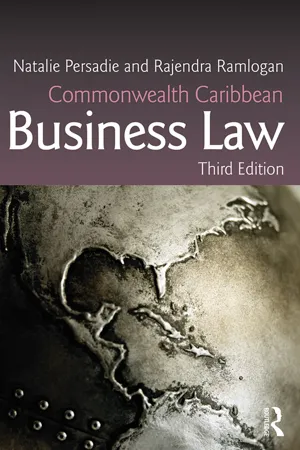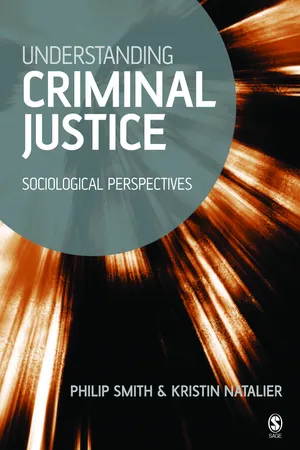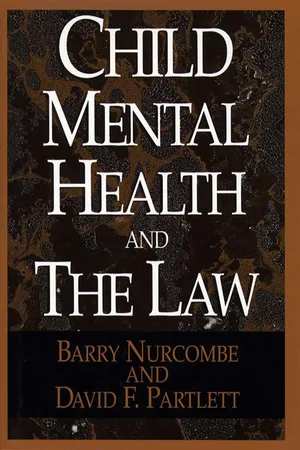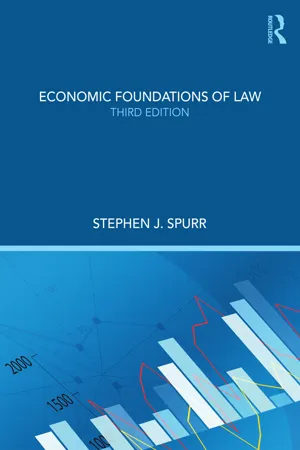Law
Legal System
The legal system refers to the framework of rules, institutions, and processes that are established by a society to regulate behavior, enforce laws, and resolve disputes. It encompasses various components such as legislation, courts, law enforcement, and legal professionals, all working together to uphold justice and maintain order within a society.
Written by Perlego with AI-assistance
Related key terms
9 Key excerpts on "Legal System"
- eBook - ePub
- Natalie Persadie, Rajendra Ramlogan(Authors)
- 2015(Publication Date)
- Routledge-Cavendish(Publisher)
Chapter 1Introduction to Legal Systems
Reproduced with the permission of Stu’s ViewsThe rule of law
Law is a social phenomenon. It has grown into an essential principle of social organisation in Western civilisations as a result of the historicity of those societies.1 Law functions as the formal machinery for creating and maintaining social order, as seen in the Western world. All societies possess some degree of order which allows for sustained social interaction within a period of time. The form of order which exists depends on the particular society and the perceived needs of that society. Political, historical and moral characteristics of a society also assist in shaping that form of order. According to Sinha, law is a composite of three components: rules of law (mental), attitudes (psychological) and external aspects (behaviour). It is these three components which shape law in any given society; however, the question begs itself, how does law maintain social order? Law prescribes what acceptable social conduct for any given society is and punishes deviant behaviour which results in conflict or disorder. There are established institutions and procedures through which the law operates in civil and criminal issues to return a society to its status quo of social normalcy.The constitutional and administrative law of the United Kingdom has long respected a number of values, many of which are encapsulated in the concept of the rule of law: checks against arbitrary power; democracy through universal suffrage and regular elections; representative and accountable government; individual freedom; fair procedures; and judicial independence.2 The intricately woven interrelationship between government and the law is reflected in the concepts postulated by the rule of law. The notion itself is fluid and lends itself to a wide range of interpretations. Despite the inability to propose a concrete definition for the concept, it is accepted that central to the general idea of the rule of law is the specific proposition that it involves the rule of law as opposed to the rule of people to control the exercise of arbitrary power. It can be said that it is usually intended to imply that the powers exercised by politicians and officials must be based on authority conferred by law and that the law should conform to certain minimum standards of justice, both procedural and substantive.3 - eBook - ePub
Understanding Criminal Justice
Sociological Perspectives
- Philip Smith, Kristin Natalier(Authors)
- 2004(Publication Date)
- SAGE Publications Ltd(Publisher)
2 The Law Introduction In our day-to-day lives, the meanings that we attach to law are relatively straightforward. ‘Law’ is often presumed to be a discrete set of rules, developed by the state and the courts, and if we get caught breaking them, we might end up in trouble. Usually, this seems pretty fair. But from a sociological perspective, law is sprawling and messy. State law is supplemented and sometimes supplanted by other rules governing social behaviour; our common-sense assumptions about the existence of justice or fairness are often more hopeful than empirically correct. This chapter presents the social scientific perspective on what we mean when we talk about ‘law’ in Western, liberal tradition. To begin, we briefly describe some of the fundamental structures and ideals of the system. We then backtrack to trace its history and consider the contemporary social context. Following this, key jurisprudential models of law are presented. From a social scientific perspective, these are not particularly useful as descriptions of how law is actually interpreted and applied in societies that are marked by systematic power discrepancies and differences. This is evident when we consider the promise and failure of objectivity and equality, and the usefulness of the public/private dichotomy. We then turn to the role and relevance of rights, a concept that has gained increasing prominence in our day-to-day discourse and as a basis for claims within the formal Legal System. It becomes evident that the promise of these concepts remains largely unfulfilled, as jurisprudential ideals compete with social realities. Legal Systems In England, the USA and Australia, ‘law’ usually means the decisions of courts and legislation. These form the basis of the common law system. This was developed in Britain and exported to its colonies, including the USA and Australia. Common law is predicated on stability and its development is piecemeal - eBook - ePub
- Richard Nobles, David Schiff(Authors)
- 2012(Publication Date)
- Hart Publishing(Publisher)
Legal philosophers have persistently attempted to explain why we think of laws as forming Legal Systems, to evaluate the merits of this way of thinking about the law, and to make it more precise by explicating the features that account for the unity of Legal Systems. Various theories have been suggested but none have been accepted as completely satisfactory, and the continuing debate owes much to the intricacy of the problems involved’ (2009, 78). 5 1961/1994. It is not only legal theorists who represent law in this way, sociological and political theory analysis of law also characterises the operation of law in similar terms. For what is now a classic statement to this effect, see Friedman, 1975, ch 1, ‘The Legal System’. 6 Raz, 2009, 115–21. 7 Sampford, 1989. 8 Van de Kerchove and Ost, 1994. 9 Dewey 1901, quoted by Sampford, 1989, 14. There are, of course, many modern alternative definitions of system and systems, especially those that both inform systems science in itself and in relation to complexity science (see, for example, Castellani, 2009, 8: ‘the celebrated insight of complexity science: all social systems, by definition, are complex’; Urry, 2005). There might be some agreement about the most general definition of a system (such as that offered by Webster’s New World Dictionary: ‘a set or arrangement of things so related or connected as to form a unity or organic whole’) but this does not mean that modern theorists who explore systems, systems theory and systems science in depth, rely on the same definition or adopt similar methodologies in their study of systems. (Webster’s definition is quoted by Klir, 2001, who also says (at 4): ‘The term “system” is unquestioningly one of the mostly widely used terms not only in science, but in other areas of human endeavor as well. It is a highly overworked term, which enjoys different meanings under different circumstances and for different people - eBook - ePub
- John Ventura(Author)
- 2011(Publication Date)
- For Dummies(Publisher)
Chapter 1
All About Our Legal System
In This Chapter
Defining lawsDrawing the line between civil law and criminal lawBreaking down the court systemDiving into contractsFollowing the lawsuit processW hat do you think of when you hear the words Legal System? If you’re like many Americans, you probably think of a courtroom where lawyers, using language you can’t understand, argue with one another, and where a jury of people you don’t know, or a judge in a black robe behind an imposingly high desk, makes decisions about your life using laws you know little or nothing about. That’s an intimidating image, but it’s only a very small part of the picture! Our Legal System is much more than just courtroom action.This chapter expands your definition of what our Legal System is by providing you with information you probably never got in high school — or don’t remember learning, anyway. Maybe you slept through class the day these things were covered! With a more complete understanding of our Legal System, you’re better able to avoid getting into legal hot water, and you feel more confident about exercising your legal rights when you do.And now for your remedial crash course on our Legal System. . . .What Are Laws and Where Do They Come From?
Our laws reflect society’s standards, values, and expectations. They establish “the rules of the game” in our personal interactions and in our business dealings, helping to ensure that we’re treated fairly and that we treat others fairly, too. Laws establish our responsibilities and our rights and help us both avoid problems and resolve problems.The laws that govern our lives come from six basic sources: the U.S. Constitution, the Bill of Rights, statute law, administrative law, common law, and case law.The Constitution
The Constitution is the granddaddy of all U.S. law, the supreme law of the land, and the standard against which all other laws are measured. It established this country as a republic and determined the structure of our Congressional system. The Constitution applies to all Americans. - eBook - ePub
- Landsberg C, S Graham(Authors)
- 2017(Publication Date)
- Van Schaik Publishers(Publisher)
The traditional view was that the courts only applied the law; they did not make it. Today, there is no question that, in the application of a rule of law to an actual case, the courts do have a law-making function (Shapiro, 1975: 342ff). This function is, however, limited and is not as comprehensive as that of the legislature. The courts make laws mainly by their interpretation and application of existing rules of law, whereas the legislature makes laws by amending or replacing existing laws and by making new laws (Rautenbach, 2012: 163). Application of the law by the courts also differs from its application by the executive. The executive, which must execute the laws made by the legislature and, in the process, must also interpret and apply the law, is always a party to the relationships to which it applies the law and to the disputes that arise therefrom. By contrast, the courts are never a party to any dispute they are called upon to resolve (Rautenbach, 2012: 163–164).4.4 The Legal System
4.4.1 Historical background
It has been mentioned that every state has a unique Legal System. A Legal System develops over time and one of the determining factors, therefore, in the nature of a Legal System is its historical background. The peculiarities of the South African Legal System can largely be attributed to our particular legal and political history. Although the South African Legal System forms part of the Western legal traditions, distinctive historical and other factors led to the development of a unique Legal System within that legal tradition. A legal tradition can be defined broadly as a family of Legal Systems displaying similarities in respect of historical development, theories, sources, methodology, key legal concepts and legal institutions (Katz, 1986: 2; David & Brierly, 1985: 20; Glendon, Gordon & Osakwe, 1982: 4–5). The three major Western legal traditions are the civil law tradition of the European continent, which stems from Roman law, the Anglo-American common law tradition, and the socialist legal tradition. In the world at large, one can also identify a distinct Islamic legal tradition, an African tradition and various Asian legal traditions (David & Brierly, 1985: 453ff). - eBook - ePub
American Civilization
An Introduction
- David Mauk, Alf Tomas Tønnessen, John Oakland(Authors)
- 2021(Publication Date)
- Routledge(Publisher)
Chapter 9 The Legal System- Legal history
- The sources of US law
- The court system
- Federal and state court proceedings
- The legal profession
- Crime and punishment
- Attitudes to the Legal System
- Exercises
- Further reading
- Websites
In her speech accepting the nomination as a Supreme Court justice in September 2020, judge Amy Coney Barrett proclaimed: “A judge must apply the law as written.” In saying so, she invoked the view of her mentor – the late Justice Antonin Scalia, who died in 2016 – and advocated the idea of “original intent.” Barrett and Scalia believe that judges should interpret what the founders meant in 1787 rather than interpret law in light of the development of society in the last 200 years. Liberals, by contrast, often argue that it is important to take the development of society into consideration and read the Constitution as a flexible document. This was a rationale behind the famous Brown v. Board of Education decision in 1954, which declared segregation of public schools unconstitutional.This chapter examines the historical development of the US Legal System, describes the court apparatus and federal and state court proceedings, considers the role of the legal profession, comments upon crime and punishment and concludes with attitudes to the Legal System. For practical purposes, this system consists of judges and lawyers who serve in independent state and federal courts, which are concerned with two main types of law (civil law and criminal law). The individual cases dealt with by the courts and other institutions are accordingly classified as either civil or criminal.Civil law involves claims for compensation (often financial) by individuals (or groups) who have suffered loss or damage through the acts of others. Domestic actions (divorce, children, and custody), automobile accidents, personal injury cases, libel and corporate matters are the main civil actions. Civil law has a service role and tries to secure social harmony by settling disputes between individuals or organizations. This is achieved preferably by settlement through litigation and negotiation. If no settlement is agreed, the case goes to a full trial. - eBook - ePub
Pursuing Justice
Traditional and Contemporary Issues in Our Communities and the World
- Ralph A. Weisheit, Frank Morn(Authors)
- 2018(Publication Date)
- Routledge(Publisher)
Part IIFormal Systems of Justice
It is tempting to think of justice in terms of individual cases. Did the rapist or child molester get what was coming to him? Were employees treated unfairly because of their race or gender? Justice at that level is important to the individual victim and to others in similar situations. Justice at the individual level is also important for society because long-term failures to address these forms of injustice can bring into question the legitimacy of society as a dispenser of justice. Ultimately, the legitimacy of society itself is brought into question.Focusing on justice at the individual level while pursuing larger societal goals is one of the main reasons for creating and maintaining governments. Numerous government agencies attempt to deliver justice. Some bureaucracies deal with poverty, race relations, workplace safety, and environmental protections. Those agencies are worthy of discussion. However, here, discussion is limited to general systems of justice, with specific reference to those agencies dealing with law and order.There are two great justice systems throughout the world: Common law and civil law. Common law systems are more familiar to Americans. They come from medieval England. Civil law systems are the oldest, most widespread, and most influential, as found in France and in many parts of South America. They come out of the ancient organizations of the Roman Empire and the Catholic Church. In addition to these two distinct systems, what might be called Colonial systems are hybrids, drawing from both the civil and common law traditions. Countries that had been colonies of civil or common law countries often take those traditions and add a particular ideology or heritage that puts a unique stamp on their notions of justice. For example, some Communist countries have civil law structures but a Marxist/Maoist ideology that make their systems distinctive. Many Islamic nations, such as Egypt, have Legal Systems based on a civil law tradition, but they are also influenced by the teachings of Islam and its scriptures in the Qur’an - eBook - ePub
- Barry Nurcombe(Author)
- 2010(Publication Date)
- Free Press(Publisher)
CHAPTER 2THE Legal System
THE NATURE AND PURPOSES OF LAW
A Functional Definition
T here have been many attempts to define the law; it would be inappropriate, in this chapter, to review the intricacies of this continuing debate. Instead, we shall explore the purposes, characteristics, sources, creation, and administration of the law in the American Legal System.American law has been greatly influenced by the positivist school of jurisprudence, which holds that there is a division between law and morality and that the law is primarily a body of rules incorporated in an assemblage of authoritative constitutions, statutes, regulations, case law, and legal conventions.The law is multifaceted. Public law regulates the relations of a citizen to his or her government, and the way that the departments of government relate with each other; whereas private law regulates the rights and obligations of citizens vis-à-vis one another. In some circumstances, this distinction becomes blurred. Tort law, for instance, was once regarded as being in the private domain since it dealt with cases in which one person would be legally obliged to remedy a wrong perpetrated upon another. Tort law thus adjusted the rights and obligations of private parties interacting with one another (an adjustment spurred by ideas of corrective justice). Today, however, tort law has evolved into a tool for the reallocation of social resources, much in the way that public law operates. In this sense, contemporary tort law is “public law in private law garb.” In contrast, contract law is more purely a private matter, for its rules are designed to facilitate commercial exchange.The Purposes of Law
Although the law is a body of rules, it is neither static nor immutable. The law changes, sometimes a little behind the times, but change it must, because its purpose is to facilitate interests and protect rights. Consequently, it may at times seem untidy or inconsistent. Oliver Wendell Holmes said: “The law is always approaching, and never reaching, consistency. It is forever adopting new principles from life at one end, and it always retains old ones from history at the other which have not yet been absorbed or sloughed off. It will become entirely consistent only when it ceases to grow.”1 - eBook - ePub
- Stephen J. Spurr(Author)
- 2019(Publication Date)
- Routledge(Publisher)
3 Introduction to the Legal SystemThis chapter introduces some legal terminology that is used throughout the text, and some basic features of the Legal System. At the same time we will show how economic analysis can be used to explain these features, which might otherwise seem completely arbitrary.We first consider the different stages and different possible outcomes of a lawsuit (a civil action). We examine the doctrine of precedent, how a lawsuit may create a precedent, and the body of all precedents, which is known as the common law. We also consider an economic analysis of the doctrine of precedent developed by Landes and Posner.There are substantial differences in the burden of proof applicable to different legal controversies. We consider an economic explanation for these differences, to illustrate how economics is used to analyze procedural issues.Finally, we consider the design of the U.S. Constitution. The founders believed that, to provide a legal foundation for the nation’s economic growth and development, the Constitution had to depart from the scheme of the Articles of Confederation, by transferring vast governmental powers from the states to the federal government. At the same time, the founders thought it imperative to ensure that this transfer of power would not lead to an undue concentration, or (in economic terms) a monopoly, of power in the central government. Accordingly, many provisions of the Constitution were designed to prevent that outcome. We will analyze the sections of the Constitution that are intended to thwart the acquisition of a monopoly of governmental power. We also examine the division of powers between the federal government and the states, including their respective courts.Although the specific institutional features we describe are those of the U.S. Legal System, the issues that arise apply to any Legal System.Litigation and the court systemA lawsuit is called an “action” by lawyers. An action is viable only if it is based on a valid legal claim, or “cause of action.” We can, and should, divide all actions between civil and criminal cases, since the substantive and procedural rules applicable to them are completely different. In a civil action a plaintiff files a lawsuit against one or more defendants; in a criminal case the accused party is the defendant, and the plaintiff is the government.
Learn about this page
Index pages curate the most relevant extracts from our library of academic textbooks. They’ve been created using an in-house natural language model (NLM), each adding context and meaning to key research topics.








